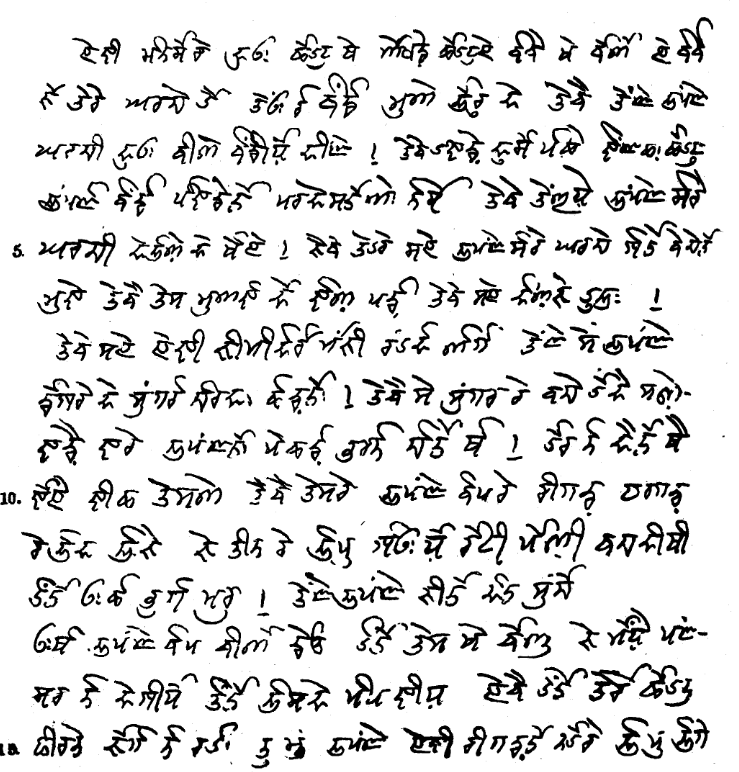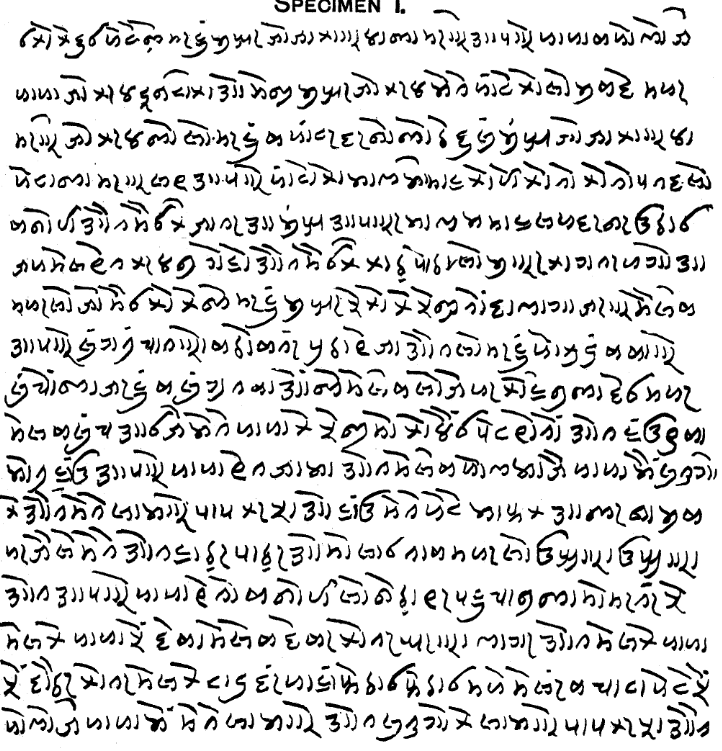|
Mahasu Pahari Language
Mahasu Pahari (Takri: ) is a Western Pahari (Himachali, Takri: ) language spoken in Himachal Pradesh. It is also known as Mahasui or Mahasuvi. The speaking population is about 1,000,000 (2001). It is more commonly spoken in the Himachal Pradesh, Shimla (Simla) and Solan districts. It is to be known that Shimla and Solan were parts of the old Mahasu district. Himachal Pradesh State on 1 September, 1972 reorganised the districts dissolving Mahasu district. The Solan district was carved out of Solan and Arki tehsils of the then Mahasu district and tehsils of Kandaghat and Nalagarh of the then Shimla District of Punjab. Area According to different locations, the language has developed several dialects. Lower Mahasu Pahari (Baghati, Baghliani, Kiunthali), Upper Mahasu Pahari (Rampuri, Rohruri, Nawari, Jubbali, Shimla Siraji, Sodochi). The Kiunthali variety appears to be understood by others, and their attitude toward it is favorable. Rampuri is also called Kochi; Rohruri is also ... [...More Info...] [...Related Items...] OR: [Wikipedia] [Google] [Baidu] |
India
India, officially the Republic of India (Hindi: ), is a country in South Asia. It is the seventh-largest country by area, the second-most populous country, and the most populous democracy in the world. Bounded by the Indian Ocean on the south, the Arabian Sea on the southwest, and the Bay of Bengal on the southeast, it shares land borders with Pakistan to the west; China, Nepal, and Bhutan to the north; and Bangladesh and Myanmar to the east. In the Indian Ocean, India is in the vicinity of Sri Lanka and the Maldives; its Andaman and Nicobar Islands share a maritime border with Thailand, Myanmar, and Indonesia. Modern humans arrived on the Indian subcontinent from Africa no later than 55,000 years ago., "Y-Chromosome and Mt-DNA data support the colonization of South Asia by modern humans originating in Africa. ... Coalescence dates for most non-European populations average to between 73–55 ka.", "Modern human beings—''Homo sapiens''—originated in Africa. Then, int ... [...More Info...] [...Related Items...] OR: [Wikipedia] [Google] [Baidu] |
Rohru
Rohru is a town and a municipal committee in Shimla district in the Indian States and territories of India, state of Himachal Pradesh. It is at the Bank (geography), banks of the Pabbar River, and it is about 115 km from Shimla city. Rohru is at . It has an average elevation of 1,525 metres (5,003 feet). Demographics India census, Rohru had a population of 14953. Males constitute 59% of the population and females 41%. Rohru has an average literacy rate of 94%, much higher than the national average of 59.5%: male literacy is 96%, and female literacy is 89%. In Rohru, 13% of the population is under 6 years of age. References {{reflist Cities and towns in Shimla district ... [...More Info...] [...Related Items...] OR: [Wikipedia] [Google] [Baidu] |
Retroflex Consonant
A retroflex ( /ˈɹɛtʃɹoːflɛks/), apico-domal ( /əpɪkoːˈdɔmɪnəl/), or cacuminal () consonant is a coronal consonant where the tongue has a flat, concave, or even curled shape, and is articulated between the alveolar ridge and the hard palate. They are sometimes referred to as cerebral consonants—especially in Indology. The Latin-derived word ''retroflex'' means "bent back"; some retroflex consonants are pronounced with the tongue fully curled back so that articulation involves the underside of the tongue tip ( subapical). These sounds are sometimes described as "true" retroflex consonants. However, retroflexes are commonly taken to include other consonants having a similar place of articulation without such extreme curling of the tongue; these may be articulated with the tongue tip (apical) or the tongue blade (laminal). Types Retroflex consonants, like other coronal consonants, come in several varieties, depending on the shape of the tongue. The tongue may be eith ... [...More Info...] [...Related Items...] OR: [Wikipedia] [Google] [Baidu] |
Alveolar Consonant
Alveolar (; UK also ) consonants are articulated with the tongue against or close to the superior alveolar ridge, which is called that because it contains the alveoli (the sockets) of the upper teeth. Alveolar consonants may be articulated with the tip of the tongue (the apical consonants), as in English, or with the flat of the tongue just above the tip (the "blade" of the tongue; called laminal consonants), as in French and Spanish. The International Phonetic Alphabet (IPA) does not have separate symbols for the alveolar consonants. Rather, the same symbol is used for all coronal places of articulation that are not palatalized like English palato-alveolar ''sh'', or retroflex. To disambiguate, the ''bridge'' (, ''etc.'') may be used for a dental consonant, or the under-bar (, ''etc.'') may be used for the postalveolars. differs from dental in that the former is a sibilant and the latter is not. differs from postalveolar in being unpalatalized. The bare letters , etc. ... [...More Info...] [...Related Items...] OR: [Wikipedia] [Google] [Baidu] |
Dental Consonant
A dental consonant is a consonant articulated with the tongue against the upper teeth, such as , . In some languages, dentals are distinguished from other groups, such as alveolar consonants, in which the tongue contacts the gum ridge. Dental consonants share acoustic similarity and in Latin script are generally written with consistent symbols (e.g. ''t'', ''d'', ''n''). In the International Phonetic Alphabet, the diacritic for dental consonant is . When there is no room under the letter, it may be placed above, using the character , such as in /p͆/. Cross-linguistically For many languages, such as Albanian, Irish and Russian, velarization is generally associated with more dental articulations of coronal consonants. Thus, velarized consonants, such as Albanian , tend to be dental or denti-alveolar, and non-velarized consonants tend to be retracted to an alveolar position. Sanskrit, Hindustani and all other Indo-Aryan languages have an entire set of dental stops that occur p ... [...More Info...] [...Related Items...] OR: [Wikipedia] [Google] [Baidu] |
Labial Consonant
Labial consonants are consonants in which one or both lips are the active articulator. The two common labial articulations are bilabials, articulated using both lips, and labiodentals, articulated with the lower lip against the upper teeth, both of which are present in English. A third labial articulation is dentolabials, articulated with the upper lip against the lower teeth (the reverse of labiodental), normally only found in pathological speech. Generally precluded are linguolabials, in which the tip of the tongue contacts the posterior side of the upper lip, making them coronals, though sometimes, they behave as labial consonants. The most common distribution between bilabials and labiodentals is the English one, in which the nasal and the stops, , , and , are bilabial and the fricatives, , and , are labiodental. The voiceless bilabial fricative, voiced bilabial fricative, and the bilabial approximant do not exist as the primary realizations of any sounds in English, bu ... [...More Info...] [...Related Items...] OR: [Wikipedia] [Google] [Baidu] |
Devanagari Script
Devanagari ( ; , , Sanskrit pronunciation: ), also called Nagari (),Kathleen Kuiper (2010), The Culture of India, New York: The Rosen Publishing Group, , page 83 is a left-to-right abugida (a type of segmental writing system), based on the ancient ''Brāhmī'' script, used in the northern Indian subcontinent. It was developed and in regular use by the 7th century CE. The Devanagari script, composed of 47 primary characters, including 14 vowels and 33 consonants, is the fourth most widely adopted writing system in the world, being used for over 120 languages.Devanagari (Nagari) , Script Features and Description, SIL International (2013), United States The |
Nastaliq Script
''Nastaliq'' (; fa, , ), also romanized as ''Nastaʿlīq'', is one of the main calligraphic hands used to write the Perso-Arabic script in the Persian and Urdu languages, often used also for Ottoman Turkish poetry, rarely for Arabic. ''Nastaliq'' developed in Iran from '' naskh'' beginning in the 13th century and remains very widely used in Pakistan, Iran, Afghanistan and as a minority script in India and other countries for written poetry and as a form of art. History The name ''nastaliq'' "is a contraction of the Persian , meaning a hanging or suspended '' naskh''". Virtually all Safavid authors (like Dust Muhammad or Qadi Ahmad) attributed the invention of to Mir Ali Tabrizi, who lived at the end of the 14th and the beginning of the 15th century. That tradition was questioned by Elaine Wright, who traced evolution of ''nastaliq'' in 14th century Iran and showed how it developed gradually among scribes in Shiraz. Moreover, according to her studies ''nastaliq'' has its o ... [...More Info...] [...Related Items...] OR: [Wikipedia] [Google] [Baidu] |
Jaunsari Language
Jaunsari () is a Western Pahari language of northern India spoken by the Jaunsari people in the Chakrata and Kalsi blocks of Dehradun district in the Garhwal region of Uttarakhand state. The dialects of Jaunsari share about 60% of their basic vocabulary with each of the neighbouring varieties of Bangani, Jaunpuri, Nagpuriya and Sirmauri Sirmauri is a Western Pahari language spoken in the Sirmaur district in the northern Indian state of Himachal Pradesh Himachal Pradesh (; ; "Snow-laden Mountain Province") is a state in the northern part of India. Situated in the Western .... Script Jaunsari was historically written in Jaunsari Script . The Devanagari script is being used these days in certain works. Status The language has no official status. According to the United Nations Education, Scientific and Cultural Organisation (UNESCO), the language is of definitely endangered category, i.e. many Jaunsari children are not learning Jaunsari as their mother tong ... [...More Info...] [...Related Items...] OR: [Wikipedia] [Google] [Baidu] |
Sirmauri Language
Sirmauri is a Western Pahari language spoken in the Sirmaur district in the northern Indian state of Himachal Pradesh Himachal Pradesh (; ; "Snow-laden Mountain Province") is a state in the northern part of India. Situated in the Western Himalayas, it is one of the thirteen mountain states and is characterized by an extreme landscape featuring several peaks .... Its two main varieties are Dharthi (also called Giriwari) and Giripari. Grammar Postpositions Script The native script of the language is called Sirmauri script. This script is under proposal to be encoded in the Unicode. It is locally known as Dhankari. Pabuuchi was a script used by a class of astrologers. Status The language is commonly called Pahari or Himachali. The language has no official status and is recorded as a dialect of Hindi. According to the United Nations Education, Scientific and Cultural Organisation (UNESCO), the language is in the critically endangered category, i.e. the youngest ... [...More Info...] [...Related Items...] OR: [Wikipedia] [Google] [Baidu] |
Hindi
Hindi (Devanāgarī: or , ), or more precisely Modern Standard Hindi (Devanagari: ), is an Indo-Aryan language spoken chiefly in the Hindi Belt region encompassing parts of northern, central, eastern, and western India. Hindi has been described as a standardised and Sanskritised register of the Hindustani language, which itself is based primarily on the Khariboli dialect of Delhi and neighbouring areas of North India. Hindi, written in the Devanagari script, is one of the two official languages of the Government of India, along with English. It is an official language in nine states and three union territories and an additional official language in three other states. Hindi is also one of the 22 scheduled languages of the Republic of India. Hindi is the '' lingua franca'' of the Hindi Belt. It is also spoken, to a lesser extent, in other parts of India (usually in a simplified or pidginised variety such as Bazaar Hindustani or Haflong Hindi). Outside India, several ot ... [...More Info...] [...Related Items...] OR: [Wikipedia] [Google] [Baidu] |




